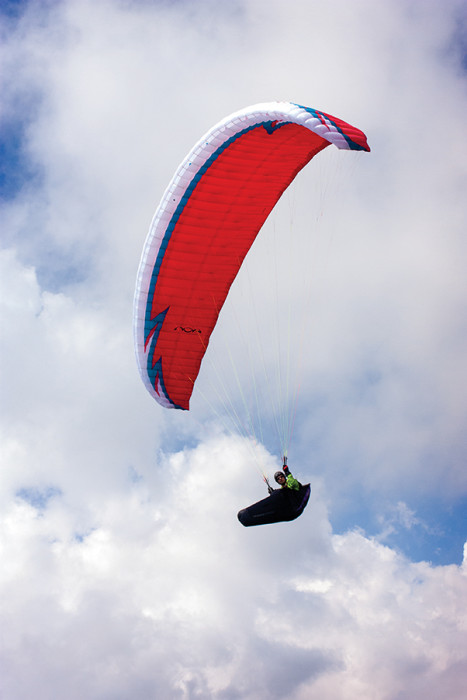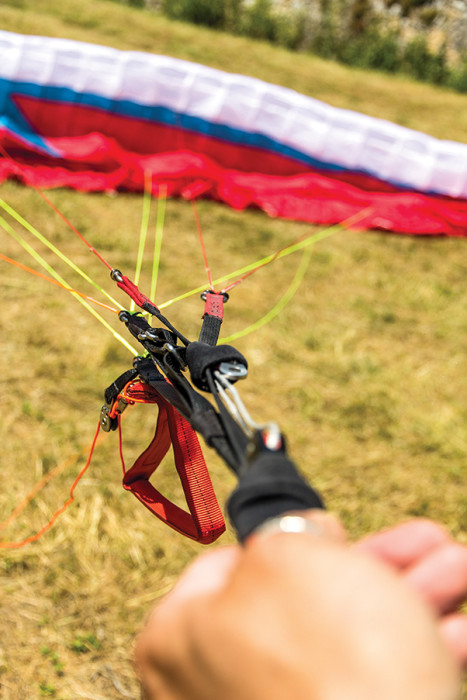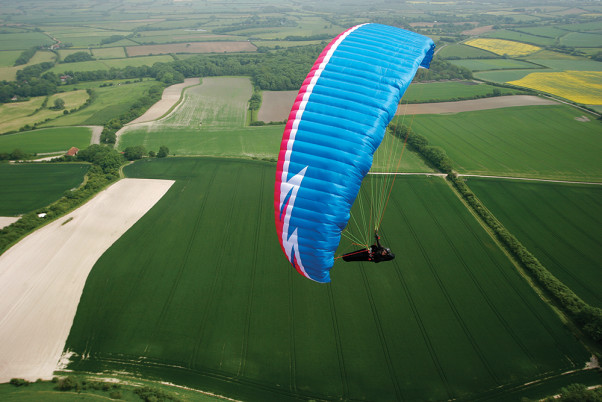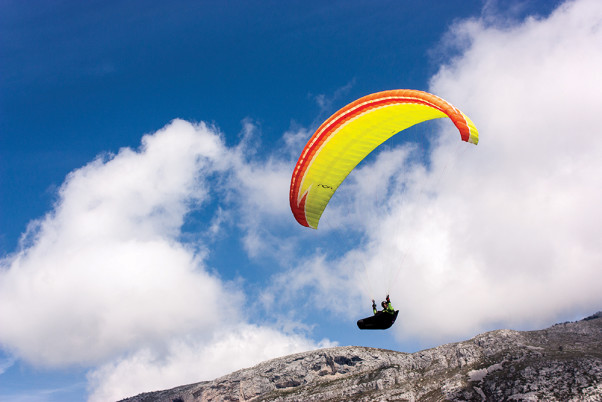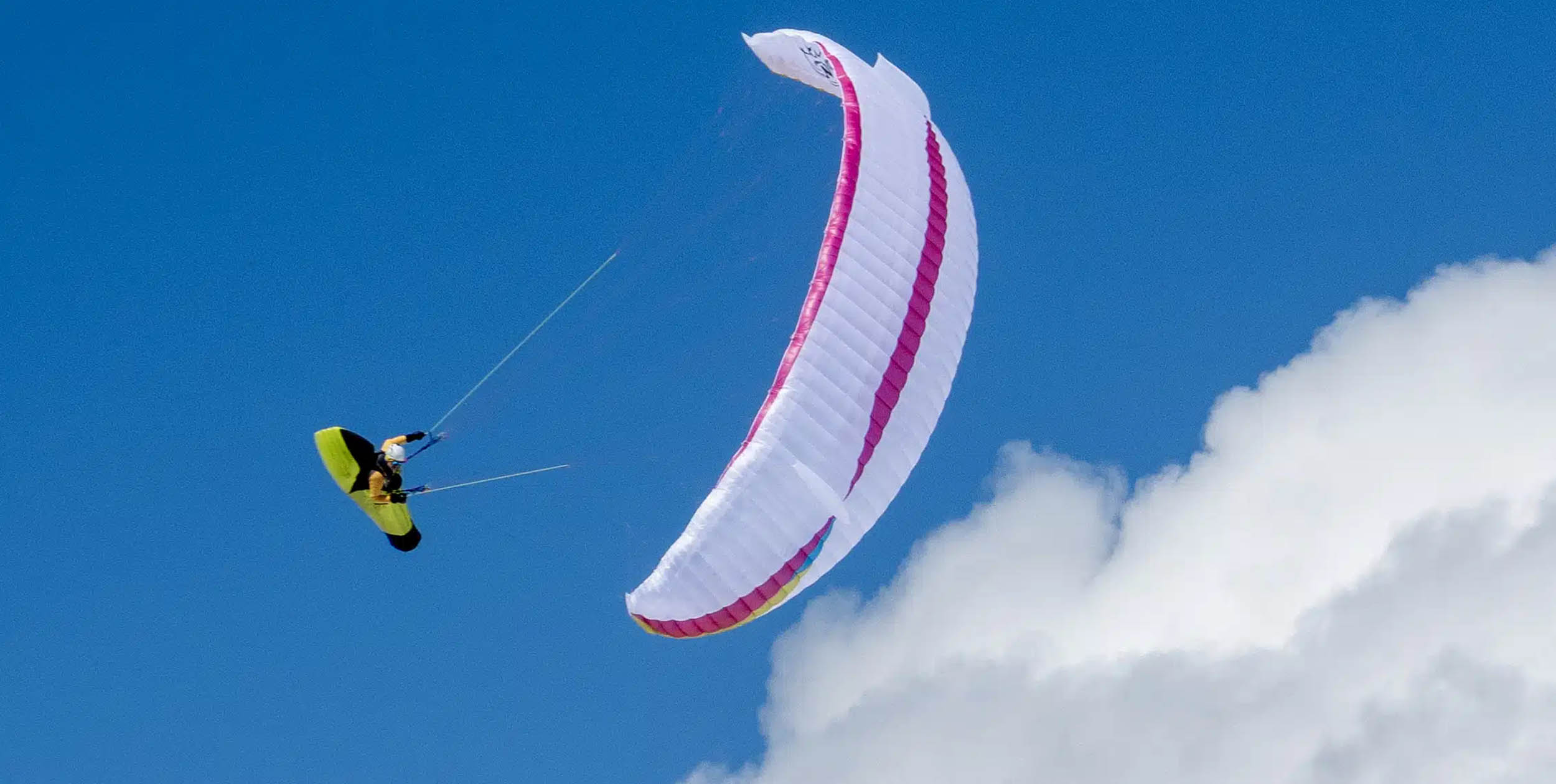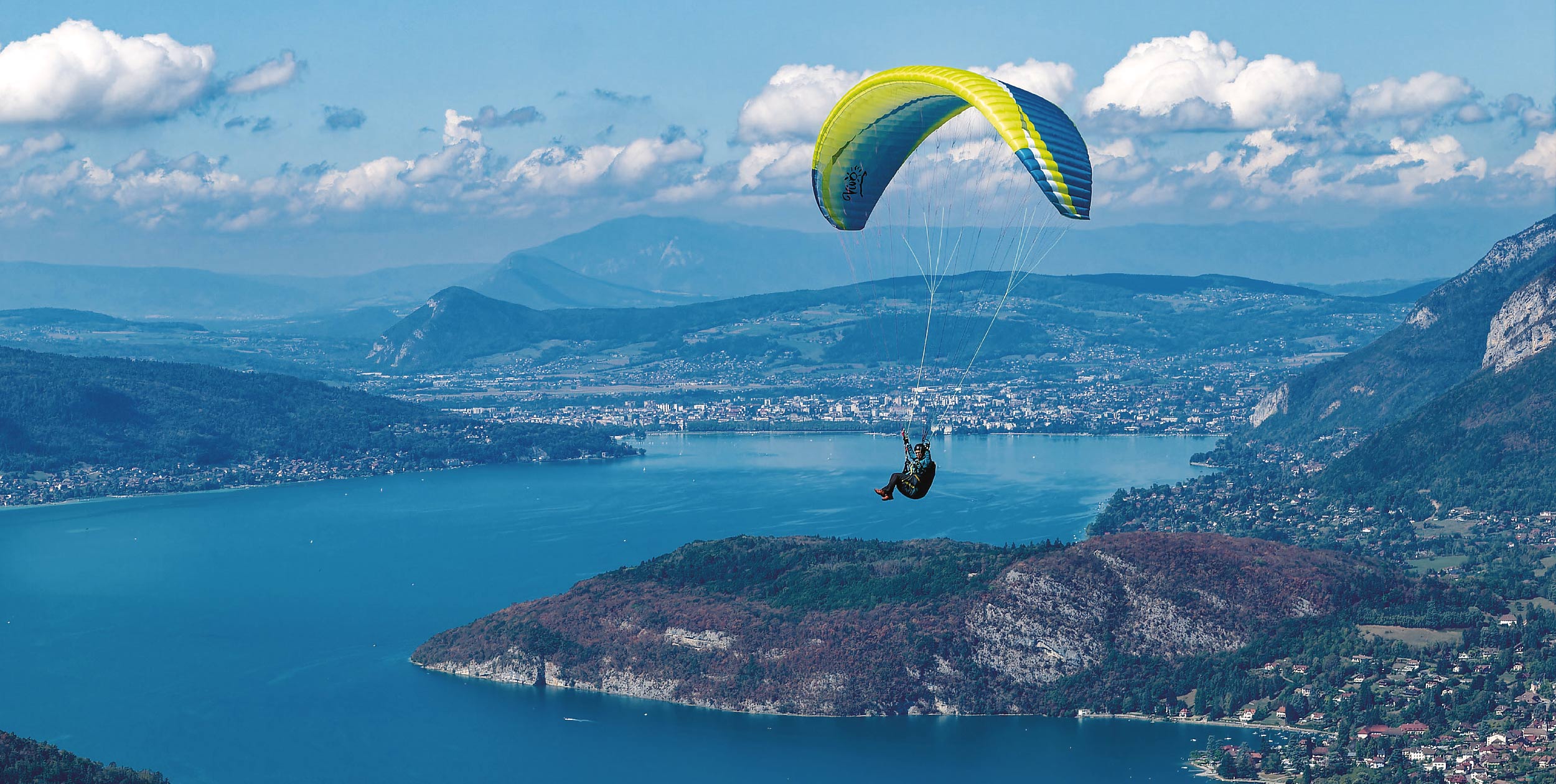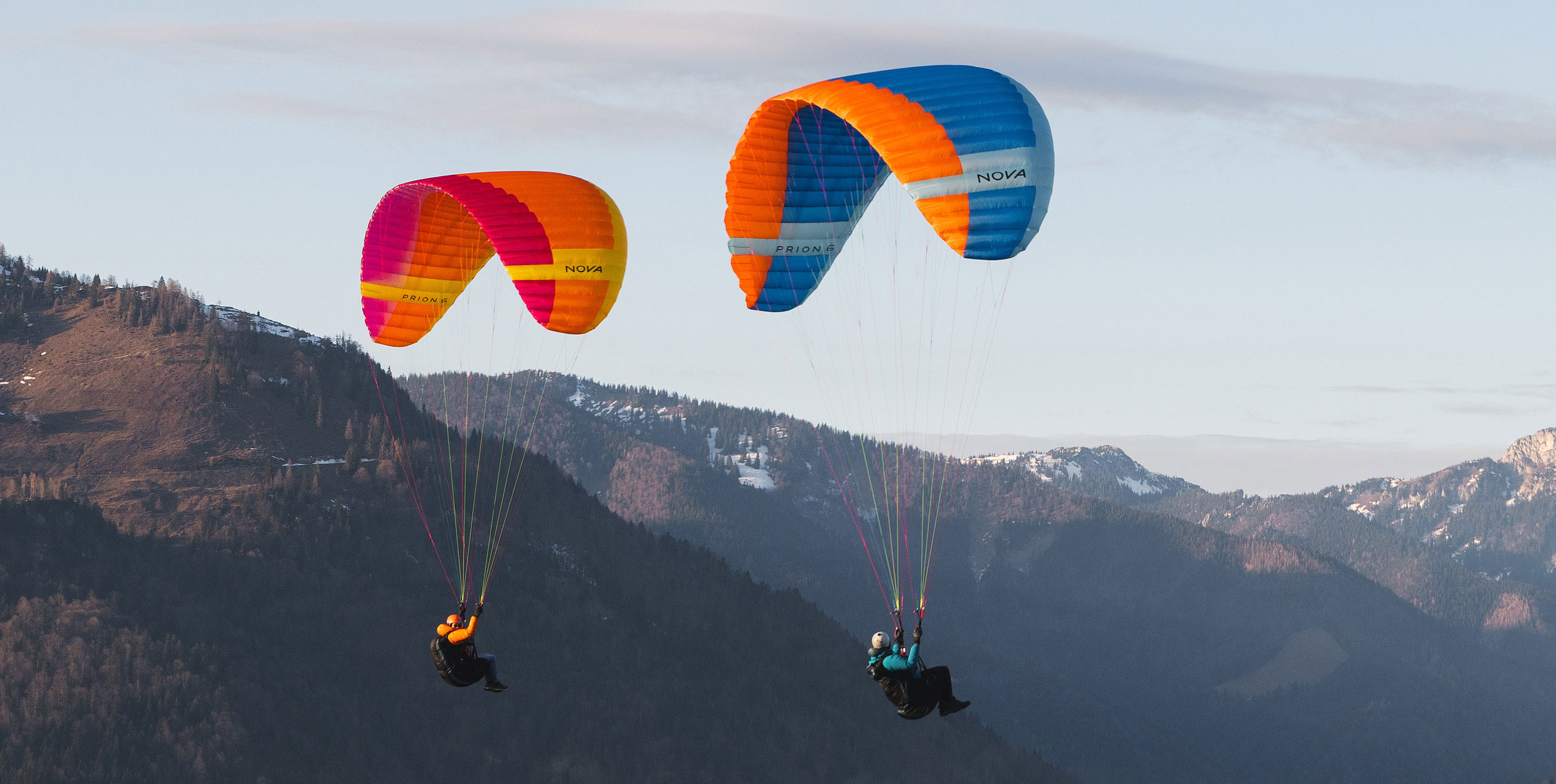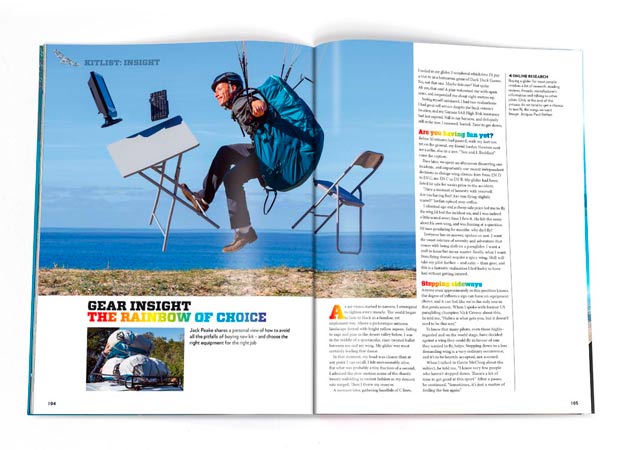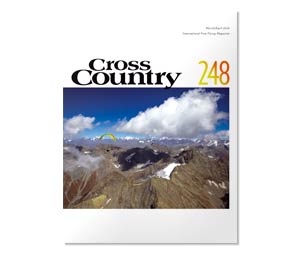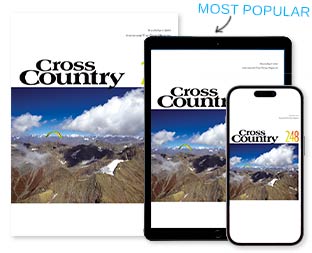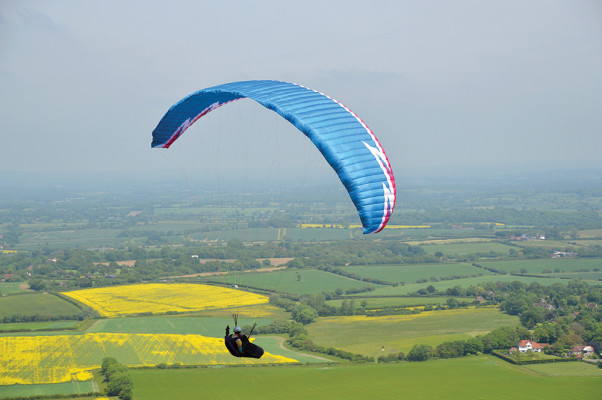
The glider has a reefing system on the brakes, which gives the trailing edge a scalloped look when the brakes are applied. Photo: Mick Stiff
They’ve done it again! Marcus King flies the hotly anticipated Mentor 3
Published in Cross Country issue 148
Two years ago when I reviewed the Mentor 3’s predecessor I found that, despite the intense interest in the Mentor 2’s performance, it was the wing’s handling that got me excited. Nova had managed to produce a wing that not only performed well, it also combined the direct handling more often found on higher-class wings with the safety of an intermediate wing. I loved it, although some pilots found it a bit lively for their liking with a bit too much feedback.
Nova has now released the Mentor 3.
Building on the Mentor 2
Nova say that the new wing is an evolution of the original, refined and optimised. The basic shape of the wing, including the relatively low aspect ratio, of the Mentor 2, is still there. The leading edge has seen work, with 3D-shaping being used to clean it up. To the casual observer this shows up as two span-wise seams on the top of the leading edge. Nova say they have also worked to improve the airflow around the tips and the air intakes after modelling the wing using computational fluid dynamics.
Although there is no shark nose, it uses the same flexible nylon rods used in the Mentor 2 as well as small Mylar inserts on the openings. The wing itself is made from Dokdo 35g/m2 cloth from Dominico. This feels pretty flimsy in your hand but Nova has been using it for a good while and back their gliders with a four-year warranty, so they must have confidence in it.
At the back end of the wing Nova have added a reefing system to the brakes. This means they have cut down on the amount of line used while, they claim, maintaining the good handling. The downside for me is that there are now so few attachments at the back that it can look a bit messy when the brakes are applied.
The lines are a mixture of sheathed and unsheathed. The unsheathed ones have a slippery coating, which seems to do its job of reducing tangles.
The wing uses three risers, but the C lines split chord-wise near the wing to go to C and D tabs for better support. The risers themselves use 10mm webbing making them sleek and simple affairs. They have split-As to make big ears easier; an example of the attention to detail is the fact that the risers are shaped at the bottom to be wider so they fit snugly in karabiners rather than sliding around. Unusually these days the brakes attach with mechanical poppers rather than magnets. They are also fitted with swivels to reduce line twisting.
First impressions
Using a reverse launch the wing rose steadily, coming to stop overhead with no dramas – as you would expect from a modern EN B wing. Once in the air the work Nova have done to make the wing feel even more secure was immediately noticeable. The wing feels planted with no nervous behaviour at all. It is dampened both in pitch and roll giving a secure feeling. “On rails” sums it up really.
With the extra comfort of this secure feeling I was worried that the sweet handling the previous model had would be lost. Surely a wing with this level of stability couldn’t get up on a wingtip. However, the first pull on a brake dispelled any worries: this wing still turns on a dime with precise handling, allowing you to dial in the amount of bank you want easily. Once in the turn the wing stays nicely banked up with the no tendency to get rocked out. Rolling in a bit of weightshift helps the turn but there is no reason to throw yourself over to one side as it is so agile using brakes alone.
Nova say that the brake pressure is now lower than the Mentor 2, but to be honest without flying them back-to-back I think it’s unlikely you would notice the difference, the brakes are firm enough without being tiring for those long flights.
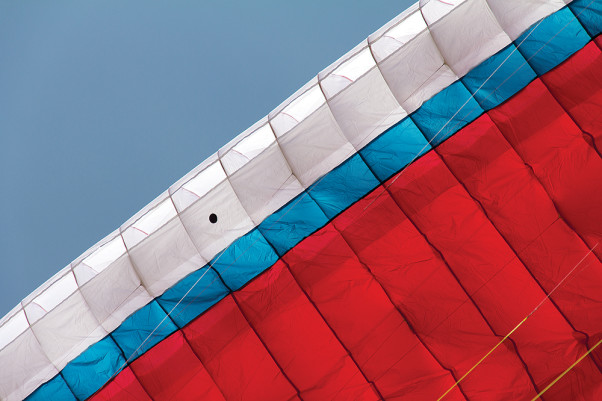
There is no shark nose, although the leading edge has been cleaned up using 3D shaping.
Photo: Marcus King
Going cross country
After my first flight I landed with a big smile on my face: I was excited at the prospect of taking this wing cross country as soon as possible. With many of the new EN C wings becoming high-aspect racing machines, wings like the Mentor 3 are being adopted as the new cross country wings for experienced pilots and Nova make much of its ability as a mile-muncher. Within a week I found myself sat on launch in the company of R11s and other race machines.
In the air the wing’s handling allowed me to thermal efficiently, coring the thermals tightly. There is no tendency for it to sit back in the turns, instead it pitches slightly forward nicely. With no need to slow it right down you have speed and energy to move within the thermal. I found I could climb as well as anything around me. The handling gives you the ability to put it in the best part of the lift and there is a good feedback from the wing without it feeling uncomfortably wobbly.
At base for the first time the cloud was building fast and spreading out. Worried about being sucked in I chose to use my preferred method of escape: big ears with bar. Using the split-risers it was easy to get relatively large ears in. Even with big ears there was no feeling that the wing would sit back towards deep stall, but adding bar helped escape the area of lift more quickly and increaseed the descent rate. The ears stayed in place well with no thrashing but took a while to open once released; the slightest use of brake saw them flick out.
Gliding normally the speedbar is easy to use; it is light enough that you can control the wing’s pitch with it. There aren’t any of the C balls or handles that have become a common feature recently. Instead you can use pressure on the C risers to feel the wing and catch any potential collapses. However, this wing doesn’t require that much management on bar and it doesn’t feel like Nova have pushed the travel to the maximum. Up high I was happily hooning about on bar despite the spring conditions.
Pushing into wind
In the past one of the things that differentiated this class of wing from its racier brethren has been their into-wind performance. Any task that included an into-wind leg often frustrated pilots of EN B wings and saw them kicking their helmets around a field after an early landing. The Mentor 3 though is one of the most efficient wings of this class that I have flown; it very rarely gets rocked back as you push into wind. My route took me out through a windy col, which could easily have seen me having to turn tail to land out. The Mentor’s calm feeling, coupled with its nice drive forward, meant I was able to push round to a better face where I was able to climb out.
Up high where I was able to push bar things were even more efficient. Sadly I wasn’t with anyone to do direct comparisons but the wing feels like it is a step up from its predecessor when pushing upwind.
Feeling Fresh
My last flight on the wing was at Lac d’Annecy. After taking off at Planfait I was quickly able to leave the crowds by heading around to the more northerly slopes where a climb quickly took me to the top of the Dents de Lanfon. From there I headed off on the usual tour of the lake. It was a day with a growing southerly wind – bumpy conditions in this area. When I landed after two-and-a-half hours in the air, having completed the tour and gone off sightseeing around the Tournette, fellow pilots had already landed complaining about the roughness of the air. I, on the other hand, had felt secure under the Mentor 3. The relaxing ride meant I was able to get the best out of the climbs, making easy decisions on where to head next. I simply relaxed and enjoyed the amazing scenery around me.
Conclusion
When asked what I thought about the Mentor 3 after landing after my first flight, I said to my friends “they’ve done it again”. And that about sums it up. Nova have built on the brilliant wing that was the Mentor 2 and refined and polished it into a real gem.
The Mentor 3 retains the great handling but gives a more comfortable ride and improves the into-wind performance. If I was being pedantic I might say it lacks a little of the zing of its predecessor, but for most pilots those changes will only be a good thing.
It’s a wing that will let you get the best out of a day with a comfortable ride that won’t frazzle your tired brain with too much information. It will happily take you for long days out in big terrain – something that has already been confirmed with several big 200km triangles logged on it this spring in the Alps.
Technical Specs
Sizes: XXS, XS, S, M, L
Weight ranges (kg):
60-80, 70-90, 80-100, 90-110, 100-130
Flat area (m2): 22.67, 25.05, 27.28, 29.60, 32.02
Number of cells: 45
Aspect Ratio: 5.12
Weight (kg): 4.9, 5.3, 5.7, 6.1, 6.5
Line consumption (m): 197, 207, 216, 225, 234
EN: B
The Ion 2, EN B
The EN B class is the most important category of wings on the market. More than 70% of the wings sold are EN B and most of the major manufacturers produce two wings in the class. But which wing is suitable for you?
Nova stress that both their Mentor 3 (high-end B) and Ion 2 (low-end B) are capable cross country wings. They say the wing you choose is down to your level and your choice. I tried an Ion 2 alongside the Mentor so I could feel the difference between the two wings.
On launch the two wings are very similar in behaviour. The Ion 2 is a bit more forgiving, but both reacted well to being pulled up off centre and neither needed a strong tug to get them to rise overhead.
In the air the Ion 2 tends to bite into thermals a little less than the Mentor 3. Its brakes have longer travel and are a bit firmer and the wing is more forgiving of input timing. I found it sat back a little in rough broken climbs and I had occasionally to push it round by putting my hands high. Having said that, it still climbs well and I was able to make good use of lift on our local thermic site.
On a normal glide there isn’t so much between these wings. Being in lifting or sinking air will make a mockery of any wingtip-to-wingtip glide tests. If you move to follow the best lifting line you will still out-fly a pilot on a higher-class wing who doesn’t feel the sky. The bar is again simple to use and the Ion 2 feels very secure at all speeds. The one place where it loses out is pushing into wind, as the wing is more likely to be rocked back which bleeds a bit of energy. If you look at the online contests you will see that this is a very capable cross country wing with several flights of over 200km logged on it.
Pulling big ears is a bit physical, a sign of how solid the wing is. They pop out easily when released. While both wings seemed very solid in the air I induced collapses on both of them to feel the difference. It has to be said that both reacted well to the 50% collapses I tried. There is only so far I will go over the ground and when collapsed and released immediately both wings recovered quickly with very little turn. The Mentor recovered its shape more quickly with a pump of the closed side, whereas thanks to the Ion 2’s higher internal pressure it needed no assistance. If the collapse is held in both wings will start to turn but the Ion 2’s rotation is slower. The main difference is the reaction to brake input when stabilising the wing. If you are proficient the Mentor 3 is easy to control, but with the Ion 2’s longer brake travel it is less precise so you are less likely to over-brake the wing which could lead to a spin.
There is no doubt the Ion 2 is safe wing capable of taking you on good cross country flights. If you are a beginner it is a perfect wing for honing your skills on, with stability and forgiving handling that will allow you to get on with making decisions without having to worry about flying the wing. It will also be more tolerant of your brake inputs if you get yourself in a worrying position, when adrenaline can often make your inputs less than ideal. If you are a pilot moving down from a higher class and fly regularly you will probably prefer the sharper handling of the Mentor 3.
• Got news?
Send it to us at news@xccontent.local.
Subscribe to the world’s favourite hang gliding and paragliding magazine

